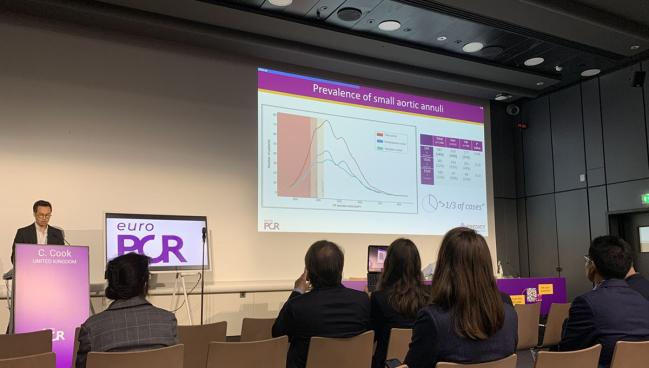PREDICT Offers a Heads-up on the Need for CT in Suspected Small Aortic Annuli
The free risk calculator can be incorporated into existing spreadsheets of patient data for use in heart team discussions.

PARIS, France—A new model for foreseeing small annulus size at the point of referral to an aortic service could give heart teams a more succinct way to determine which cases merit CT and potentially cut back on patient-prosthesis mismatch, the PREDICT study suggests.
While preplanning CT is ubiquitous in TAVI, it’s much less often used in surgical AVR cases, often because of resource constraints, noted Christopher Cook, MBBS, PhD (Essex Cardiothoracic Centre, England), who presented the study in a session here this week at EuroPCR 2025.
Particularly in the case of younger patients with severe aortic stenosis put into a surgical pathway, “you may lose sight of them and you may not be able to get them a CT unless you have flagged them as high risk at the point of referral to an aortic service,” Cook told TCTMD.
Ultimately, Cook said, the last thing a patient or a physician wants is to find out at the time of AVR that the annulus is very small and may increase the risk for patient-prosthesis mismatch and other issues.
Results of the score, known as PREDICT, are “additional data to use in discussions with our patients on the pros and cons of various management strategies based on a clear picture of their annulus size,” he advised. “It could change the narrative on how you manage the patient upstream and on what they know going into their procedure.”
Excellent Predictive Accuracy
PREDICT sought to develop and validate a model using anthropometric data combined with information from a transthoracic echocardiogram (TTE) as well as left ventricular outflow tract (LVOT) dimension.
The study included 1,708 patients (mean age 82 years; 40% female) with a mean ejection fraction of 53%. Of these, 34% had small aortic annulus: categorized as either small (≤ 430 mm2), very small (≤ 400 mm2) or extremely small (≤ 370 mm2).
Patients were then split into a development cohort (n = 912) and a validation cohort (n = 796).
“The percentage of patients in our development cohort was consistent with what we see in the real world, with about one-third of patients having small annulus,” Cook said.
The investigators found that three key factors—height, sex, and LVOT dimension—closely correlated with CT annular area. Those variables were used to create the PREDICT model, which was tuned for high sensitivity and high negative predictive value.
The PREDICT score’s performance across the small, very small, and extremely small groups showed good to excellent predictive accuracy, with area under the curve (AUC) values of greater than 0.84 across all size thresholds. Additionally, it outperformed height and LVOT dimension when tested against those individually. Analyses by age (younger or older than 75 years) showed no impact on diagnostic sensitivity or specificity.
[PREDICT] could change the narrative on how you manage the patient upstream and on what they know going into their procedure. Christopher Cook
Philippe Pibarot, DVM, PhD (Laval University, Quebec City, Canada), one of the session’s moderators, said he views LVOT as the most vulnerable parameter in the score.
“This measure . . . is subject to measurement variability and error, and intra-observer variability,” he noted. “And of course, garbage in, garbage out. If you have a big error in the LVOT diameter, this may alter the results.”
Cook said while they haven’t tested how an under- or overestimation of LVOT might impact the formula and the classification into annulus size categories, 90% of the LVOT data in the model came directly from the referral echo form and were not calculated by the investigators. However, he said it might be a good way to test the model’s tolerance and better understand which of the three factors—LVOT, sex, and height—is driving the predictive value.
An Easily Incorporated Tool
Although studies like the SMART trial, which focused on patients with small annuli, have been overwhelmingly female, not every woman or every person with a small body size has a small annulus. This is yet another reason why a newer method might be welcomed by clinicians.
“When you sit in a heart team meeting, the patient is not there. You have an echo on the screen, but you've got no idea if that patient is small or large,” Cook noted. In generating the model, PREDICT showed that body surface area and body mass index both had very poor correlation with annulus size.
The investigators envision the PREDICT score as a free calculator that could be embedded in existing referral databases.
”It's essentially just an additional column on your spreadsheet that flags ‘small annulus detected.’ So, you would have a column for gender, TTE/LVOT, and height. Then on the right, you have a column that autopopulates the PREDICT score,” Cook added.
To TCTMD, he noted that another positive contribution of the score for heart teams is that it can be calculated by administrative staff at the point of referral.
“The only physician involvement in this process will probably be to authorize the CT based on agreement that the patient is at high risk for small annulus,” he said. “I don’t see this as added information that is going to contribute to physician fatigue or be a burden to use.”
L.A. McKeown is a Senior Medical Journalist for TCTMD, the Section Editor of CV Team Forum, and Senior Medical…
Read Full BioSources
Cook C. Patient referral evaluation to determine indication for computed tomography to identify small aortic annulus size in patients with severe aortic stenosis. Presented at: EuroPCR 2025. May 20, 2025. Paris, France.
Disclosures
- Cook reports honoraria/consulting fees from Edwards Lifesciences, Boston Scientific, and Philips.





Comments